
402.
It was April 13, 2016: the third time Stephen Curry had set the record for 3-pointers made in a single season, in just four years. He and his teammates on the Golden State Warriors were collectively making more 3-pointers than any other team ever before, and it was working: they were bound for the NBA Championship.
The numbers show that other NBA teams are following the Warriors’ lead: Houston Rockets coach Mike D’Antoni suggested his team could eventually average more than 50 3-point attempts a game (they’re currently just over 40). It begs the question on the eve of Selection Sunday: is this transition playing out at all levels of the game?
I recently wrote about how Curry’s 3-point prowess has impacted NBA shooting overall, using a similar data tool that I expect many professional teams are leveraging to inform their coaching strategies. Accordingly, I was curious to see how the college game has changed as a result. My assumption was that college teams were mirroring the Warriors’ strategy, but I also wanted to know if teams shot more 3-pointers, would they perform better in the March Madness tournament?
Overview
Using data from Sports Reference, I looked specifically at:
- Team statistics for all Division I teams from 1993–2017
- NCAA tournament results for the past ten years
- Current AP Top 25 teams (as of March 6th, 2017)
My hypotheses were:
- Shooting more 3-point shots results in higher shooting efficiency
- High 3-point accuracy is necessary to go deep into the tournament
- Successful underdogs shoot more 3’s due to the high variance nature of 3-point shots
To test these, I compiled statistics from the last ten years of the March Madness Tournament from 2007–2016.
TL;DR
Now, I realize some of you probably want to learn the impact of this modeling on your March Madness bracket, so at a snapshot glance, here’s what I discovered:
- College teams, like those in the NBA, are shooting more 3-pointers
- In the past ten years, high 3-point shooting volume and elite accuracy have not been an indicator for March Madness success (e.g. making it to the Final Four or better)
- However, Cinderella teams have taken more 3-pointers than their higher seeded counterparts
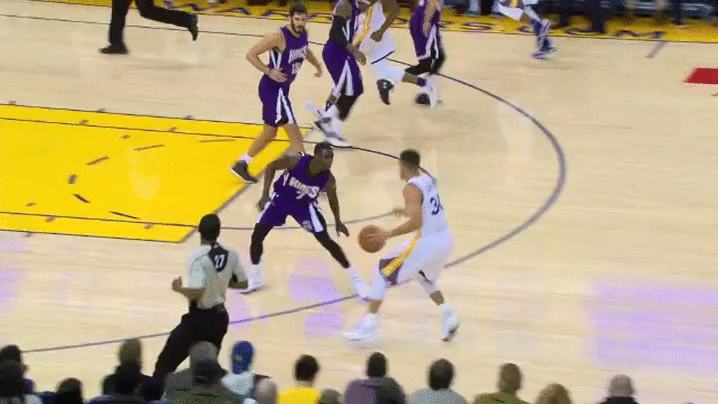
It’s Raining 3s!
College teams are shooting more 3-point shots than ever, with the 2016–17 season on pace to see a record-breaking 36 percent of total shots coming from downtown. Three point attempts have been on the rise nearly every year in college basketball, with a notable exception of the 2008 season when the NCAA moved the college line out one foot to 20 feet 9 inches.
This trend is particularly interesting relative to the NBA, which has also observed a year-over-year increase in total attempts. Beginning with the NBA, both leagues have observed a sharp uptick in the past five years, arguably due to the success of Curry and the Warriors.
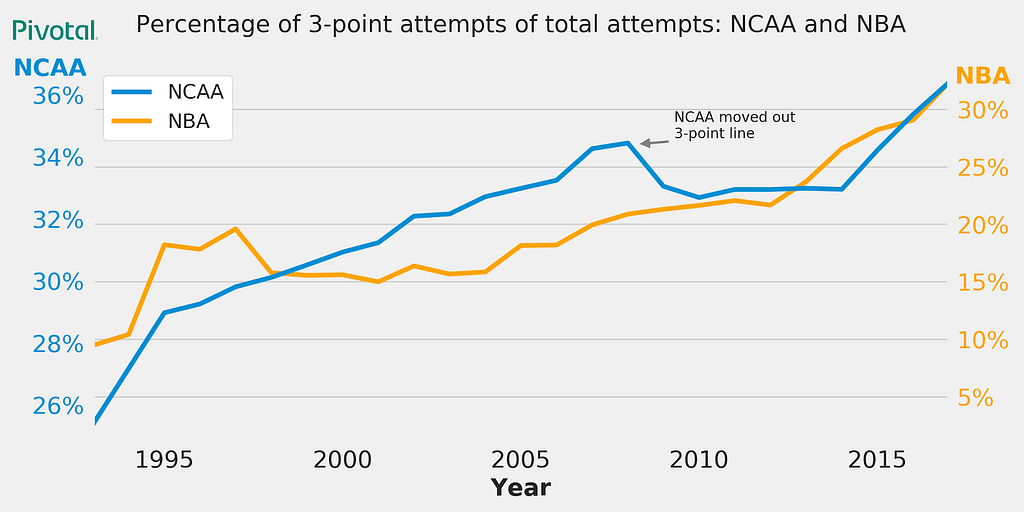
A driving factor behind the recent upsurge in 3-point attempts is shot efficiency. As Dan D’Antoni, Marshall’s basketball head coach and brother of Mike D’Antoni, explained in an interview, “You can go get any computer and run what the best shots are and it will tell you the post-up is the worst shot in basketball. If you want to run down and try to get it [in the paint] to shoot over somebody, then you’re beating analytics. The best shot in basketball is that corner three. The next-best shot in basketball is any other three. Other than free throws, which we try to do, when you get to the foul line, you score 1.5 points every time you go to the foul line in the pros. It just trickles down. It’s the same thing for college kids…”
Accurate 3-point shooting has intrinsically a higher value compared to a contested, closer 2-point shot. Accordingly, teams use effective shooting percentage (eFG%) as a metric for a more complete picture of a team or player’s shooting value: because eFG% adjusts for the fact that while a 3-point shoot typically returns a lower field goal percentage (FG%), it should be valued higher because it’s worth 50 percent more than a 2-point shot. Although shooting a lot of 3-pointers isn’t the only way to achieve a high eFG% (high 3-point accuracy and close-to-the-basket 2-pointers help a lot), it is certainly correlated.
In the figure below, I fit a best fit line to show this relationship. Although I used all data for the regression model, for visualization purposes I’ve excluded from the plot three teams that shoot above 30 3-point shots a game, including Savannah State which is shooting a mind-boggling 40.5 3-pointers a game!
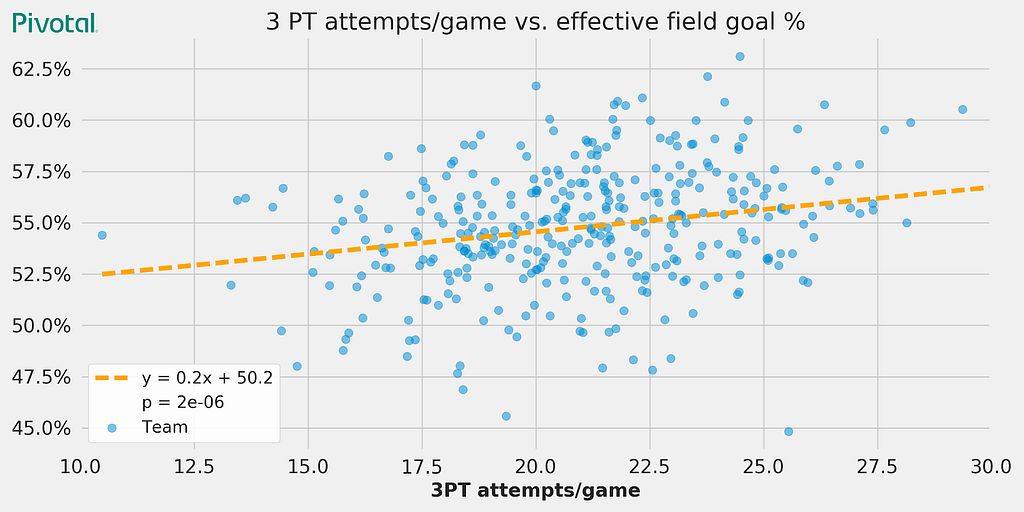
March Madness
There’s no question that teams are shooting more and more 3-pointers, representing a fundamental shift in how the game is played. So how do 3-point shooting habits relate to a team’s success in the Tournament? The answer: it depends.
It shouldn’t come as a surprise that having a top eFG% is a strong indicator for a team’s success in the March Madness tournament. Five of the past 10 National Championship winners have ranked within the top 25 of all Division I teams in eFG% for their respective championship season.
Below is a chart highlighting that three of the top five teams today in eFG% rank among the top teams in college basketball.
While the trend has shown an increase in 3-point shooting across both leagues, of the past 10 winners of the Tournament, all of them have actually attempted just under the league average per game of 3-point shots. However, collectively their 3-point accuracy (38 percent) was above average compared to the the league (36 percent). This trends applies to Final Four participants as well, thus high 3-point shooting volume and accuracy are not necessarily indicators of a team’s likelihood to succeed in the tournament.
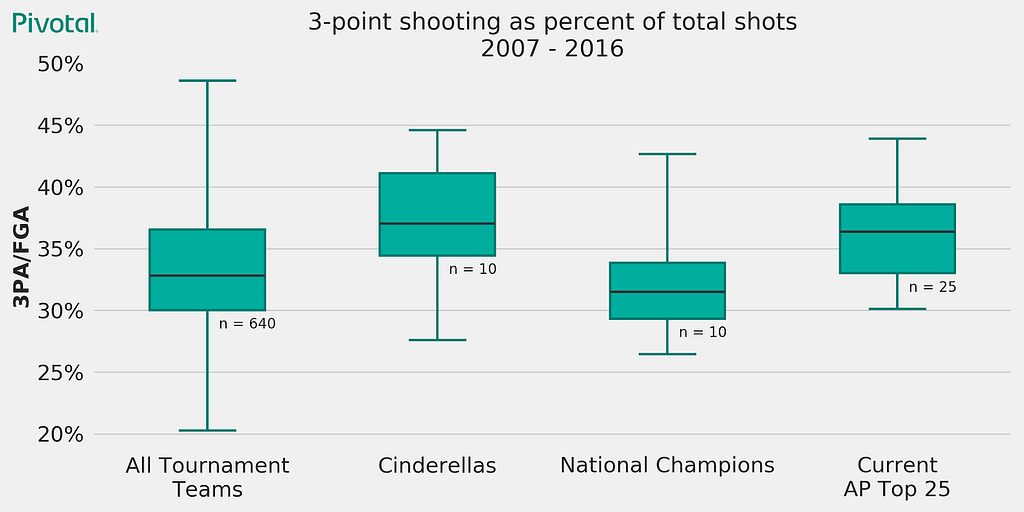
However, things get more interesting when we look at Cinderella teams who tend to shoot more 3-pointers than their higher seeded counterparts. Since the availability of our dataset from 1993 until present, 86 percent (166/192 teams) of teams that have made it to the Elite 8 round or better have been seeded sixth or lower, so for the sake of this post we’ve defined teams seeded sixth or higher as “Cinderellas.” Using the pace-invariant 3-point attempts over field goal attempts (3PA/FGA), we see these teams have shot 35% of total shots from beyond the arc, which is 5% higher than their top seeded counterparts who shot 30% (a statistically significant result at the 1% confidence level using both a Kolmogorov Smirnov test and t-test.
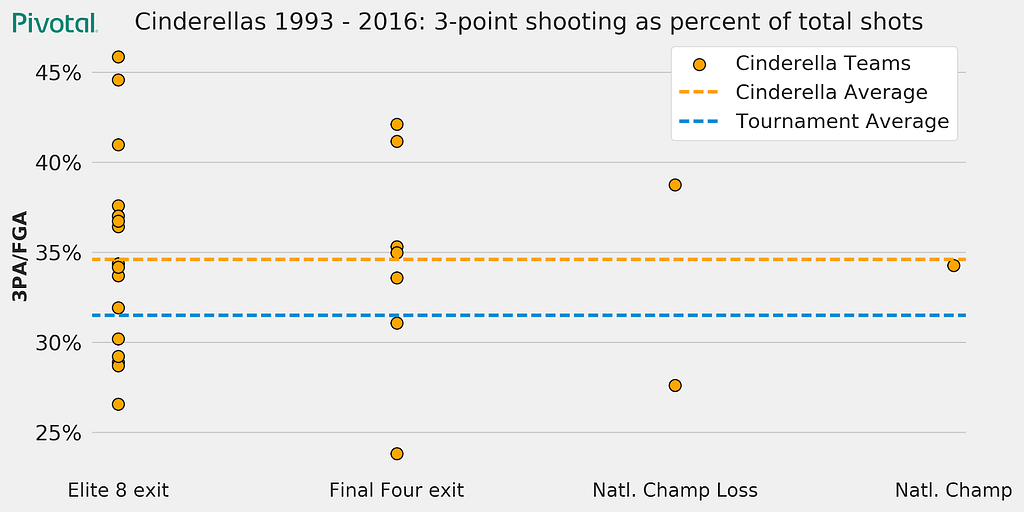
For successful teams, we can also look at how 3-point shooting varies as a function of tournament seed. In the below figure, I have shown all of Elite 8 participants over the past 10 years and have fit a linear regression line for this trend. We can see a clear correlation between seeding and 3-point shooting. In short, successful lower seeded teams rely more on the 3-point shot compared to higher seeds.

By definition, Cinderella teams are less common, but given past history, it is apparent that Cinderella teams take more 3-point shots. This is not a coincidence. There is a strong foundation suggesting that underdogs should shoot for 3-point shots due in part to their high variance nature. Accordingly, a hot 3-point shooting streak can be just the tool for propelling an undermatched team to the top. In essence, three-point shots, though more mathematically “risky” give underdogs their best chance to get lucky.
Of course, 3-point shooting is just one metric to analyze a team’s potential tournament success, and it’s important to also consider other offensive and defensive metrics for a more complete picture of the story. However, based on the analysis presented in this post, of the teams taking at least 25 3-pointers per game, six of them are likely to enter the tournament: Akron, UNC Wilmington, Princeton, Vanderbilt, Winthrop, and UT Arlington. If their shots are falling in the coming weeks, these prolific 3-point shooting teams are in a great position to go deep in the tournament.
Data, changing the game
Beyond the sheer spectacle of Curry’s 402 three-pointers, that late season game vs. the Memphis Grizzlies represented a new paradigm on the court: offensive big men dominating the paint were no longer the primary focus for building a championship team, rather a team of guards with high eFG% could propel a team to success.
While prolific 3-point shooting is not a tell-tale sign of tournament success for all teams, it can be a valuable tool for propelling Cinderellas deep into the tournament. Three-point shooting is on the rise for college basketball, and I expect teams will continue to follow the Warriors and Rockets’ lead, attempting more shots from downtown than ever before.
Which college teams do you think have the 3-point skills to go deep in this year’s Tournament?

Change is the only constant, so individuals, institutions, and businesses must be Built to Adapt. At Pivotal, we believe change should be expected, embraced and incorporated continuously through development and innovation, because good software is never finished.

How Curry Ball Will Impact March Madness Brackets was originally published in Built to Adapt on Medium, where people are continuing the conversation by highlighting and responding to this story.
About the Author
























